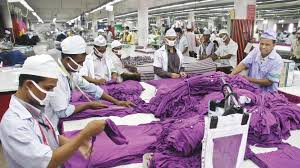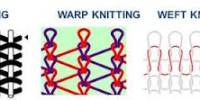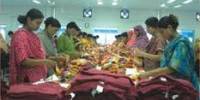Executive summary
This report consist of a number of parts. First part is history. Here we mentioned the origin on garments sector in Bangladesh & contribution of it. In the second part we present the contribution of garments sector in GDP. Here we mentioned how our garments contribute in GDP in different years. In the thirs part we describe about the export condition of garments sector in Bangladesh. Here we describe how our garments make a strong position in global market. The fourth part continuous the problem of garments sector. In this parts we highlighted the problems of garments workers. We also mentioned the possible solutions. In the last part we present the trade union movement to garments sector. Here we describe the contribution & the problems of trade union to the garments sector.
History
Bangladeshi Garment Industry is the largest industrial sector of the country. Though the history of Readymade Garment Industry is not older one but Bangladeshi clothing business has a golden history. Probably it started from the Mughal age in the Indian subcontinent through Dhakai Muslins. It had global reputation as well as demandable market around the globe especially in the European market.
After industrial revolution in the west they were busy with technological advancement & started outsourcing of ready made garments to meet up their daily demands. Many LDC’s took that chance & started ready made garment export at that markets. As an LDC Bangladesh took this chance enjoyed quota & other facilities of them. Thus ready made garment industry started to contribute in our economy from late eighties (1977).
The history of the garment industry dates back to 1977 when the first consignment was exported to then West Germany by Jewel Garments. The number of units, however, remained a meager 46 until the end of 1983. From a humble beginning the sector has thus made phenomenal growth over the last two decades, the number of units growing to around 4500. The RMG industry achievement is noteworthy, particularly for a country plagued with poor resource endowments and adverse conditions for industrialization. Exports increased from approximately 32 million US dollars in 1983/84 to 1.4 billion dollars in 1992/93. In 1987/88, the RMG export share surpassed that of raw jute and allied products. The figure further rose to 5.7 billion dollars in 2003/04, representing a contribution of about 75 percent of the country’s total export earnings in that year. The employment generated by the sector is estimated to be around 1.5 million workers.
Several factors account for the outstanding successes of the RMG industry in Bangladesh. At the same time this industry had faced & till facing many problems also.
Bangladesh is a tropical country in South Asia that is situated in the delta of two major rivers that flow down from the Himalayas (the Ganges and the Jamuna). The country’s land surface is therefore largely composed of alluvial silt, rendering the soil highly fertile. Historically, this has made Bangladesh an agricultural nation; although agriculture contributes only about a fifth of the national GDP, it employs three-fifths of the labour force (ADB, 2005).
Bangladesh has an estimated population of 140 million (circa 2005), living in an area of about 55,000 square miles. It thus has the unwanted distinction of being the world’s most densely populated country, and this overpopulation is at the root of many of Bangladesh’s socioeconomic problems. However, the population is largely homogeneous in terms of ethnicity, language, and religion, and this provides a valuable element of national cohesion.
In spite of numerous constraints, the economy has been on a steady growth path for the last 15 years, mainly due to private sector dynamism. The constraints include pervasive political instability and violence, endemic corruption and disregard for the law, frequent natural disasters, inefficient state-owned enterprises that are hotbeds of trade unionism lack of political will to carry through necessary economic reform, inadequate infrastructure at all levels (power generation, roads and highways, port facilities), etc.
Nevertheless, the economy has proved to be resilient. Since 1990, it has grown at an average rate of 5% per year. The Asian Development Bank projects that real GDP growth will increase to 6% in 2006 and 2007 (ADB, 2005). Bangladesh’s total GDP stood at $275 billion in 2004, and per capita GDP was $2,000 (adjusted for purchasing power).
KEY ECONOMIC INDICATOR2007-2008
Sectorally, services constitute the largest portion of GDP with 51.7%. Industry accounts for 27.1% and agriculture 21.2%. However, the distribution of the labour force is reversed, with most people still working in agriculture (61%), followed by services (27%) and finally industry (12%). This imbalance between output and employment is indicative of a large amount of “disguised” unemployment and underemployment. Unemployment (including underemployment) is estimated to be about 40%. The poverty rate, as of 2004, is about 45%.
As shown by the above table, merchandise exports have been growing strongly in recent years and this trend is set to continue. While imports also exhibit strong growth, it should be noted that the bulk of imports consists of inputs into the production process, e.g. machinery and equipment, fuel and petroleum products, chemicals, iron and steel, cement, fabric and accessories (for garments production), etc. The breakdown of various exports by sector is given in the table overleaf (Bangladesh Bank, 2005). The figures are for the 2007-2008 fiscal year.
|
As can be seen from Table 2, garments and textile items are the dominant export product, accounting for 77% of the country’s total export receipts. This is a relatively new phenomenon. For centuries, the chief export of the Bengal economy was jute, a natural fibre which is used in making carpets, sacks and hessian, but whose economic value went into precipitous decline after the advent of plastic bags and synthetic packaging material.
| Bangladesh is the second largest exporter of knitted garments in value terms to Canada after China from the group of countries i.e. India, China, Pakistan, Bangladesh, Sri Lanka and Vietnam. |
| There has been a 22.93% increase in export of knitted garments in value terms to Canada in value terms by Bangladesh. |
| Export of woven garments by Bangladesh to Canada has increased by 5.83% in value terms in 2008. |
| Overall there has been 14.04% increase in export of apparel by Bangladesh to Canada in 2008 in value terms. |
EXPORT DYNAMICS OF BANGLADESH GARMENTS SECTOR
Bangladesh’s exports have marked significant shifts since 1990s to a ready-made garment-centric one,Which make up the bulk (about two-third) of the export earnings. Its phenomenal expansion from an Insignificant sector in the 1970s to a major supplier of garments in the global market is mostly attributed to the multi-fiber agreement that expired on December 31, 2004. In fiscal 2004-05, the RMG constitutes about 74.15 per cent of the total export earnings, up from just little above one per cent in 1981-82. Apart from RMG, frozen food is the second largest export earning sector, which constitute 5.13 per cent followed by jute goods, leather and chemical products that respectively account for 3.24 per cent, 2.78per cent and 1.59 per cent respectively in the fiscal 2004-05.
In terms of export destinations export underwent important changes over the decades. The USA and the EU became the most important export destinations of Bangladeshi products in the global market.
Bangladesh’s exports to the two major export markets registered growth throughout the 1990s. While in1981-82, the American region account for only 9 per cent of the total Bangladesh exports, the share roseto 28 per cent in the USA. The EU has become the largest market for Bangladeshi goods with export share rising to 53 per cent from 17 per cent over the same period. This transformation is clearly Discernable from the following figures.
Trade Union Movement In Garments Sector
Trade Union movement in garments sector is very weak. Even it is weaker than other sectors. There are 8 country wide registered trade union federations. There are 9 federations registered as division based. Another 5 registered federations are combined with Jute, Textile and leather Sector. Apart from these, there are 6 unregistered federations in this sector. There are 3 alliances in the garment sector. These are: 1. Bangladesh Garments Workers Unity Council. 2. Bangladesh Garments Workers and Employees Unity Council. 3. B.N.C.C. (Bangladesh Coordinating Committee, affiliated with (ITGLWF).
Reasons of The Weakness Of Trade Union Movement In Bangladesh
Main Reason of the Weakness of trade union movement of garment sector in Bangladesh are: 1. Disunity and division of organizations. 2. Unlimited and long working hours. 3. Absence of Job security. 4. Migration from factory to factory. 5. Absence of weekly holiday and other holidays. 6. Maiority of women. 7. State policy. 8. Elite class ownership. 9. Low wage. 10. Unemployment of the country.
National Garments Workers Federation
National Garments Workers Federation is a countrywide registered Independent, Democratic and Progressive Trade Union Federation of garment workers in Bangladesh. The federation was established on 1984. There are 28 registered trade unions (plant unions) affiliated with the NGWF. Beside these, the federation has 1016 factory committees. From 1984, the federation is involved in all the important movements including several countrywide strikes in the garment sector. Total membership of the federation is: 20.000 paying member: 5.100 and Non paying: 14.900.
Central Office of the federation is at 27/11/1 Topkhana road, Dhaka-1000. There are 3 others branch offices of the federation in Chittagong, Saver and Tongi.
The federation is run by its written constitution and participations of its members in a democratic way.
Aims and Objectives
- Ensure fair wages.
- Establish the Workers Rights and Human Rights.
- Ensure the equal wages and equal rights for the women workers.
- Improve the working condition and environment in working places.
- Struggle for a democratic, developed and progressive society.
- Unite the garment workers.
- Formation of plant level unions.
- Initiate and Conduct the countrywide movements for the betterment of garment workers.
- Support, cooperate and conduct the factory base movements.
- Awareness building among the garment workers.
- Training and education for the garment workers.
- Special training and education for the woman workers.
- Legal aid for the members and garment workers.
- Publicize the workers and other materials for the garment workers in local and easy language.
- Cooperate to get new jobs for the unemployed and dismissed workers.
- Awareness building for health and environment and to provide health facilities.
- Organize meetings, processions, demonstrations, seminars and symposiums for the garment workers.
- Support and participate in the movements of other sectors, democratic movements and women freedom movements.
- Express and show solidarity with international trade union movements, democratic movements and women movements.
Main Activities
Problems of Garments worker:
1. poorly served by labour laws
2. promote and protect workers’ rights and enforce
3. too much of trade unionism
4. Do not provide weekly holiday, casual leave, a bearable increase in their wages and safe conditions of work in the factories.
5. the lowest salary
6. Govt. is not trying to serve the interests of garment workers
7. Do not implement any worker health and safety measures
8. Do not pay workers their salaries on time
9. Do not have appointment letters, identity cards, service books to use as proof of employment
10. An employee may work a maximum of 10 hours a day and 6 days per week but workers in Bangladesh are allegedly forced to work 14 to 16 hours a day and seven days in a week.
11. No safety measures
12. No residential facilities
13. They do not get tips, pensions or life insurance, and after retirement, many garment workers have to go back home without any money at all in hand.
14. Workers, especially female workers, alleged that although there were physicians in some of the factories the level of care is not good, and there is little or no medicine there.
15. Some times they work whole night.
16. Overtime work is compulsory and forceful
17. There is no doctor, first aid, sufficient light and ventilation
18. There are no sufficient and pure drinking water and toilets for the workers
19. Maternity leaves is absence
20. Do not have the day care centers
21. Management does not ensure the security of the women workers. Women workers faced rape and sexual harassment out side the factories and some times inside the factories
22. Women workers are deprived from Equal wage, Equal dignity, Equal rights and Equal promotions.
Solution:.
1. Take care of employee interest: the owners of the garments should take care the need of the employees properly.
2. Take part in decision making: the owner should take the decision of the worker for making main decision.
3. Govt. should be liberal: Govt. should not impose the unnecessary law against export import of garments product.
4. Economic fall should be avoided.
5. Improvement of buying house: the staff of buying house should take garments related training and gather knowledge.
Conclusion
The Ready-Made Garments (RMG) industry occupies a unique position in the Bangladesh economy. It is the largest exporting industry in Bangladesh, which experienced phenomenal growth during the last 25 years. By taking advantage of an insulated market under the provision of Multi Fibre Agreement (MFA) of GATT, it attained a high profile in terms of foreign exchange earnings, exports, industrialization and contribution to GDP within a short span of time. The industry plays a key role in employment generation and in the provision of income to the poor. To remain competitive in the post-MFA phase, Bangladesh needs to remove all the structural impediments in the transportation facilities, telecommunication network, and power supply, management of seaport, utility services and in the law and order situation. The government and the RMG sector would have to jointly work together to maintain competitiveness in the global RMG market. Given the remarkable entrepreneurial initiatives and the dedication of its workforce, Bangladesh can look forward to advancing its share of the global RMG market.
















